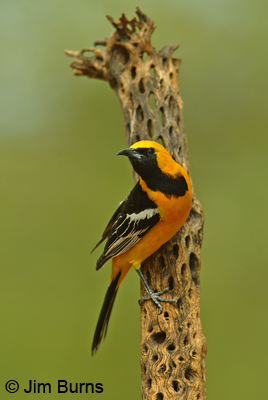
Our yard list stands at 59. That’s for nine years, perhaps respectable for a small residential yard in the Valley, but miniscule compared to the 128 for our friends Joe Woodley and Jo Ann Loza who live in the foothills of the Huachucas outside Sierra Vista. We do have two water features, four hummingbird feeders, and the Scottsdale Greenbelt two blocks away. Still, we haven’t had a new yard bird yet this calendar year.
When we moved here nine years ago and started our list, one of our most wanted birds was Hooded Oriole, arguably the most spectacular bird regularly nesting in the urban Valley. What’s not to gasp about—coal black face, bib, and back in breathtaking contrast to the yellow/orange body so bright my photoshop program often flashes a message that the color is out of gamut when it comes from my camera. Our first Hooded, an adult male, finally showed up for a drink at our front fountain five years later on June 19, 2009. Curious, though, because we never saw it again. The date was long past spring migration but too early for fall migration, and we had hoped it might be a neighborhood resident.
Our second Hooded Oriole came this April, a female, and considering past history we figured it was just a migrant. Two days later, however, a male drank at the fountain and then retreated up into the Olive tree. Our next door neighbor has Fan Palms, one of urban Hoodeds favored nesting trees. Although Mary Jo Ballator at Ash Canyon B&B suggests that if orioles come and don’t find grape jelly and orange halves they’ll never return, we were hopeful and sprang into action—jelly and citrus under the old Olive tree.
Nothing. Nothing for four weeks.
One of our hummingbird feeders hangs behind a large trellis, always in the shade, not six inches from the window by my computer. Imagine my shock on May 7 when, out of the corner of my eye, I caught a shape larger than a hummingbird, turned my head, and saw a female Hooded RIGHT THERE, balanced on the swaying feeder, drinking. It left, ignoring the jelly and the citrus. Nothing more for two weeks while the jelly fermented and the oranges rotted.
On May 17 Deva saw the female again (or a different one) on one of the hummingbird feeders in the back yard. Sure, she went out and placed fresh jelly and oranges under the backyard Olive tree. Nothing for two days. Until the female bathed in the front fountain late one afternoon, after which of course we transferred the bright orange feeder with the oriole goodies back to the front yard after refreshing the bait. No more orioles.
Peak nesting season for Hooded Orioles is mid-May. Next year we’re getting another feeder. We’ll put one in front and one in back beginning in mid-March, refresh it every few days, and leave it up through May. Sounds like a good plan. Stay tuned.